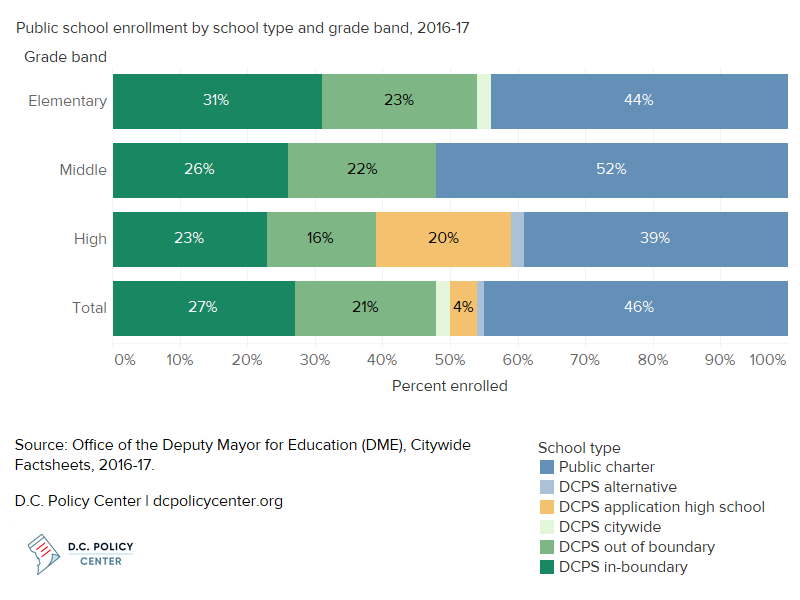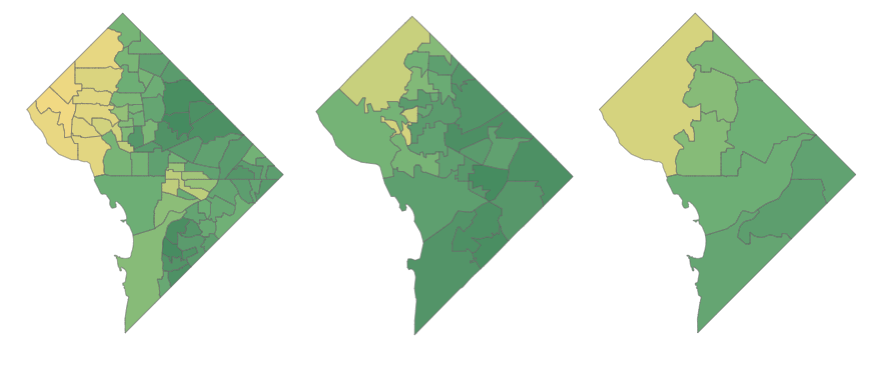How do public charter school participation rates vary across the city, and which public charter schools enroll many students from the surrounding area? This blog post examines public charter school outcomes as a follow up to the D.C. Policy Center report, Schools in the Neighborhood: Can Neighborhood Characteristics Explain Enrollment at In-boundary Schools?
Public school enrollment patterns
Citywide, 46 percent of all public school students attended public charter schools in school year 2016-17. Enrollment in public charter schools was highest in middle school grades, at 52 percent, and lowest in high school grades where DCPS application high schools attracted 20 percent of all high school students.

Public charter school participation rates are consistently lowest in western D.C.
For our analysis, we calculated public charter school participation rates for each in-boundary neighborhood, or the proportion of students living within an in-boundary neighborhood who attend public charter schools anywhere in the city. Public charter school participation rates are lower where boundary participation is highest, especially in the Wilson HS boundary where there are no public charter schools. In most neighborhoods, most students who do not choose to attend their in-boundary school attend a public charter school (as opposed to a DCPS school from out-of-boundary). About 35 percent of school boundary neighborhoods are “majority” charter, meaning that more than half of students living in a school boundary attend a public charter school instead of the DCPS boundary school or a DCPS school from out-of-boundary. However, there are few school boundaries in which most students attend public charter schools – no school boundary neighborhood has a public charter school participation rate higher than 64 percent.
Proximity to public charter schools matters for public charter school enrollment
Families who live close to a public charter school are more likely to attend them.[1] Each public charter school per square mile in a school boundary increases public charter school participation rates by between 1 and 2 percentage points for elementary school students,[2] and some students attend a public charter schools that is very close to home. Citywide, at least 7 percent of students attend a public charter school that is located within their school boundary, compared to 46 percent of students who attend a public charter school anywhere in the city. Most public charter elementary schools draw less than 20 percent of their students from the school boundaries where they are located. See below which public charter elementary schools enroll the most students from the school neighborhood where they are located, and how these students from the neighborhood compare to total enrollment.
Additional information
Click here to read the full report, download the report as a PDF, or access the data and methodology.
Schools in the Neighborhood constructs 109 neighborhoods around each DCPS in-boundary school, and assembles a profile of neighborhood characteristics and boundary participation rates for each in-boundary school. The report investigates how boundary participation rates in these neighborhoods vary with the neighborhood’s characteristics (such as race and ethnicity, household income, access to transit, safety, and proximity to charter schools) separately at the elementary school level and at the middle and high school level. The findings highlight schools that enroll a higher or lower proportion of in-boundary students compared to schools in neighborhoods with similar characteristics, and identifies neighborhood characteristics of areas where families are most likely to send their children to public charter schools.
Notes
[1] Public charter schools could be choosing their locations based on the demand from families cost of space, or other factors, so this finding does not indicate a causal relationship.
[2] Coffin, C. (2018). Schools in the Neighborhood: Can Neighborhood Characteristics Explain Enrollment at In-Boundary Schools? D.C. Policy Center. Available at: dcpolicycenter.org/publications/schools-in-the-neighborhood/
